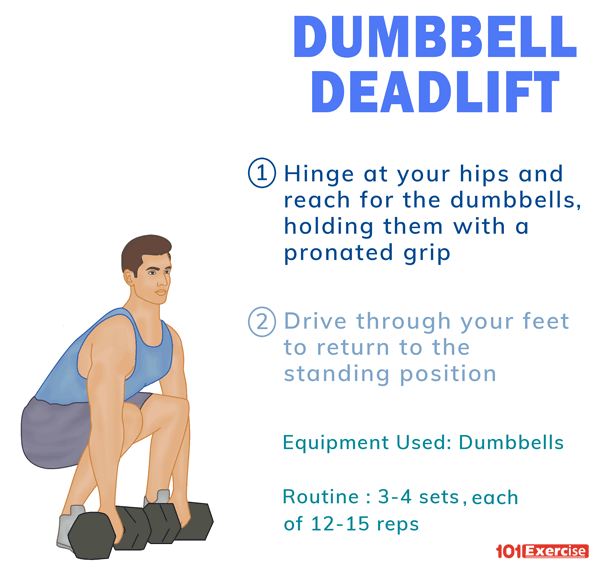Dumbbell Deadlift
- Alternative Names: Deadlift with dumbbells
- Type: Strength
- Experience Level: Beginner
- Equipment: Dumbbell
- Muscles Targeted: Hamstrings, lower back, glutes, quads
- Mechanics: Compound
- Average Number of Sets: 3-4 with 12-15 reps each
- Variations: Stiff leg, single leg, single arm, burpee, suitcase dumbbell deadlift
- Alternative: Dumbbell Romanian deadlift, pull-through with kettlebell swing
The dumbbell deadlift is usually performed by trainees as a functional exercise to gain strength that is needed to do other weightlifting movements, like squats, rows, and presses. By doing it, you can engage your hamstrings, quads, glutes, and lower back muscles, just like the barbell version. Since it increases your strength and endurance, you will be able to do daily activities without getting tired.
Benefits
- Increases grip strength by engaging your forearms, making them become prominent.
- Allows you to do the movement without a spotter safely. You can drop the dumbbells if you fail on the deadlift.
- Can be easily performed at home because the dumbbells are lighter and take up less space than a barbell.
Dumbbell vs Barbell Deadlifts
Although both the deadlifts involve the same movement, the dumbbell version requires you to engage your stabilizer muscles more to keep the dumbbells still. Aside from muscle engagement, the two exercises differ in the following ways:
The Form
The dumbbell deadlift adds more versatility, as it allows you to alter the position of the dumbbells so that you may do the exercise by placing the dumbbells in front of your feet (similar to the barbell version) or at your sides (called the dumbbell suitcase deadlift).
Weight Capacity
The dumbbell deadlift does not let you lift higher weights because most gyms do not have dumbbells weighing more than 100 lbs. As a result, the dumbbell version is an ideal exercise for the beginners. On the other hand, the barbell deadlift enables you to get weights on and off the bar so that you can lift more weights than the dumbbell variety. It is suitable for the experienced lifters who want to increase their muscle size and strength.
How to do Deadlifts with Dumbbells
Start with a pair of dumbbells, weighing about 30-45 lbs and gradually work your way up. Standing with a shoulder-width stance, place the dumbbells in front of your feet. Dropping your hips slightly, reach down and hold the dumbbells using a pronated grip. Make sure to keep your head up with your eyes looking forward throughout the movement.
Deadlift with Dumbbells Tips
- Do not arch your neck or curl your chin while performing the movement. Ensure that your head is in a straight line with the spine.
- If your grip strength does not allow you to lift higher weights, you may use lifting straps.
Variations
- Dumbbell Stiff Leg Deadlift: Performed by keeping your knees stationary and lowering the dumbbells so that they are over the top of your feet.
- Single Leg Dumbbell Deadlift: Done by raising one leg off the floor and extending it backward.
- Single Arm Dumbbell Deadlift: A variation performed by placing a dumbbell between your legs, involving press and pull movements.
- Dumbbell Burpee Deadlift: Combines plank and then requires you to jump forward to a sitting position, extending your hips to perform the deadlift.
- Dumbbell Suitcase Deadlift: Performed by holding one or two dumbbells at your sides like a suitcase.
Alternative Exercises
- Dumbbell Romanian Deadlift
- Pull-through with Kettlebell Swing

